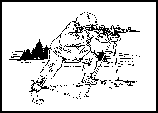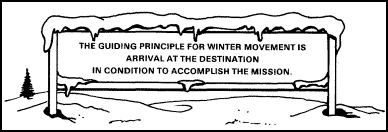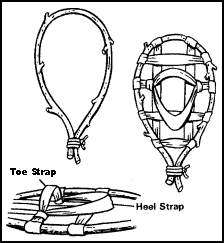|
Soldier's Handbook for Individual
Operations and Survival in Cold-Weather Areas
TC 21-3
CHAPTER 8
Individual Movement
|
"Anticipate every situation which can arise in battle and think
out your reaction to it well in ADVANCE." |
|
Hoote
|
8-1. GENERAL
Snow affects movement many ways. Heavy snow cover hinders or slows movement,
either cross-country or on roads. Snow cover also blankets many terrain features
and hides obstacles.
The effect of snow on movement varies greatly with its depth and physical
characteristics. Men on foot cannot travel well over flat terrain or roads when
the snow is deeper than 30 centimeters. However, movement can be improved by the
use of skis or snowshoes.

Figure 8-1. Using skis or snowshoes.
8-2. SKIS
Skis provide greater speed in moving, particularly over cleared trails.
Troops mounted on skis and towed behind small unit support vehicles, or similar
vehicles (ski-joring), are effective means for rapid cross-country movement. In
heavy vegetation, skiing will always be more physically taxing than
snowshoeing.
8-3. SNOWSHOES
Learning how to use snowshoes requires less training. Snowshoe movement is
more practical in confined areas, such as assembly positions, field trains, and
mortar and artillery positions. If traveling on foot, you should become skilled
on both skis and snowshoes.
Your ability to use, and the availability of, over-snow equipment is a major
factor in learning to travel well over snow-covered terrain. With previous
training in cross-country skiing and if equipment is available, travel on skis
is recommended. In most snow conditions and over most types of terrain, skis
provide the fastest and most energy-saving form of travel. Use of snowshoes
requires little training, but your speed will be slower and travel more
exhausting.
Snowshoes are more exhausting than skis. However, a light crust on the
surface of the snow prevents skis from sinking and provides for fast and easy
skiing. A crust hard enough to support a man makes travel on foot feasible, but
even then travel on skis is recommended.
In a survival situation, improvise equipment for travel if snow is loose and
deep. Make snowshoes of willow or other springy wood using a wood separator and
thong, wire, cord, etc.
USE SKIS WHEN:

USE SNOW SHOES WHEN:


Figure 8-2. Improvised snowshoes.
|
|
Approved for public release;
Distribution is unlimited.
The listing of any non-Federal product in this CD is not an endorsement of the
product itself, but simply an acknowledgement of the source.
Bureau of Medicine and Surgery
Department of the Navy
2300 E Street NW
Washington, D.C
20372-5300 |
Operational Medicine
Health Care in Military Settings
CAPT Michael John Hughey, MC, USNR
NAVMED P-5139
January 1, 2001 |
United States Special Operations
Command
7701 Tampa Point Blvd.
MacDill AFB, Florida
33621-5323 |
*This web version is provided by
The Brookside Associates Medical Education Division. It contains
original contents from the official US Navy NAVMED P-5139, but has been
reformatted for web access and includes advertising and links that were not
present in the original version. This web version has not been approved by the
Department of the Navy or the Department of Defense. The presence of any
advertising on these pages does not constitute an endorsement of that product or
service by either the US Department of Defense or the Brookside Associates. The
Brookside Associates is a private organization, not affiliated with the United
States Department of Defense.
Contact Us · · Other
Brookside Products

|
|
Operational Medicine 2001
Contents
|
|





